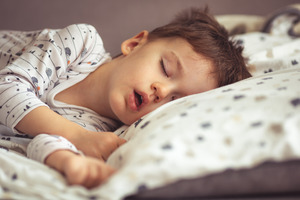
Sleep apnea is more common in adults, but that doesn’t mean that it can’t affect children. In fact, it’s estimated that between 7% and 11% of children have sleep apnea or another nighttime breathing disorder. As a parent, it’s important to learn as much as you can about this disorder so that you can protect your child from the worst of its consequences. This means familiarizing yourself with the causes and symptoms of children’s sleep apnea in San Ramon – as well as how it can be treated.
What Causes Sleep Apnea in Children?
Sleep apnea is characterized by repeated pauses in breathing that occur while the patient is asleep. This is often caused by the airway being partially or fully obstructed in some manner.
In children, sleep apnea can potentially be the result of enlarged tonsils in the back of the mouth or enlarged adenoids in the back of the nose. The excessive amount of tissue can end up blocking the flow of air, thus disrupting your little one’s breathing.
Additionally, children’s sleep apnea can be the result of obesity, specific medical conditions such as Down syndrome, or an overly large tongue. It should be noted that a family history of sleep apnea could increase your child’s chances of also developing the disorder.
What are the Symptoms of Sleep Apnea in Children?
If your child has sleep apnea, you may notice them snoring loudly or experiencing pauses in their breathing while they’re asleep. They may also be prone to breathing through their mouth, and they might experience sleep terrors or bedwetting.
On top of that, children with sleep apnea may exhibit behavioral issues, such as hyperactivity. They could also have trouble focusing, and consequently, their performance in school might suffer. Other symptoms may include morning headaches and poor weight gain.
Not every child with sleep apnea has the exact same symptoms; for instance, some might not snore. Nevertheless, you should always keep an eye out for the warning signs of sleep-disordered breathing so that you can have the problem addressed as quickly as possible.
How Can Sleep Apnea in Children Be Treated?
A sleep study will need to be performed in order to confirm whether your child has sleep apnea. Then, an appropriate treatment plan can be devised based on your child’s specific situation. Sometimes, it may be necessary to remove the tonsils or the adenoids. In other cases, your child may benefit from wearing an oral appliance that helps keep their airway open.
Sleep apnea can prevent your child from enjoying quality slumber, but you can help them get a good night’s rest again by being aware of the potential warning signs and acting quickly to have the disorder diagnosed and treated by an expert.
About the Author
Dr. Rashpal Deol began his dental career in India, where he earned a Doctor of Dental Science and a Bachelor of Dental Surgery. Today, he is a member of the American Board of Dental Sleep Medicine. At his current San Ramon practice, Oak Ridge Dental, he treats children and adults alike, and he’s proud to offer oral appliance treatment as a non-surgical solution for sleep apnea. To schedule a consultation with Dr. Deol, visit his website or call (925) 735-6190.




